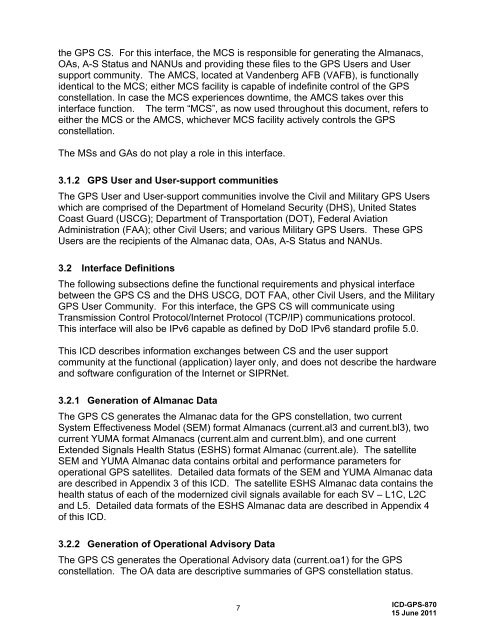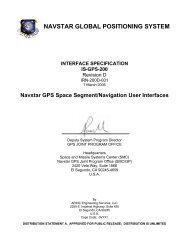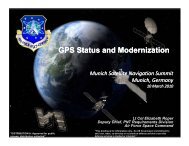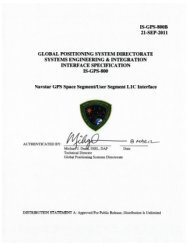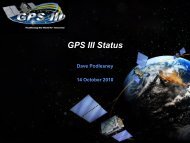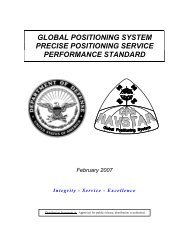Create successful ePaper yourself
Turn your PDF publications into a flip-book with our unique Google optimized e-Paper software.
the <strong>GPS</strong> CS. For this interface, the MCS is responsible for generating the Almanacs,<br />
OAs, A-S Status and NANUs and providing these files to the <strong>GPS</strong> Users and User<br />
support community. The AMCS, located at Vandenberg AFB (VAFB), is functionally<br />
identical to the MCS; either MCS facility is capable of indefinite control of the <strong>GPS</strong><br />
constellation. In case the MCS experiences downtime, the AMCS takes over this<br />
interface function. The term “MCS”, as now used throughout this document, refers to<br />
either the MCS or the AMCS, whichever MCS facility actively controls the <strong>GPS</strong><br />
constellation.<br />
The MSs and GAs do not play a role in this interface.<br />
3.1.2 <strong>GPS</strong> User and User-support communities<br />
The <strong>GPS</strong> User and User-support communities involve the Civil and Military <strong>GPS</strong> Users<br />
which are comprised of the Department of Homeland Security (DHS), United States<br />
Coast Guard (USCG); Department of Transportation (DOT), Federal Aviation<br />
Administration (FAA); other Civil Users; and various Military <strong>GPS</strong> Users. These <strong>GPS</strong><br />
Users are the recipients of the Almanac data, OAs, A-S Status and NANUs.<br />
3.2 Interface Definitions<br />
The following subsections define the functional requirements and physical interface<br />
between the <strong>GPS</strong> CS and the DHS USCG, DOT FAA, other Civil Users, and the Military<br />
<strong>GPS</strong> User Community. For this interface, the <strong>GPS</strong> CS will communicate using<br />
Transmission Control Protocol/Internet Protocol (TCP/IP) communications protocol.<br />
This interface will also be IPv6 capable as defined by DoD IPv6 standard profile 5.0.<br />
This <strong>ICD</strong> describes information exchanges between CS and the user support<br />
community at the functional (application) layer only, and does not describe the hardware<br />
and software configuration of the Internet or SIPRNet.<br />
3.2.1 Generation of Almanac Data<br />
The <strong>GPS</strong> CS generates the Almanac data for the <strong>GPS</strong> constellation, two current<br />
System Effectiveness Model (SEM) format Almanacs (current.al3 and current.bl3), two<br />
current YUMA format Almanacs (current.alm and current.blm), and one current<br />
Extended Signals Health Status (ESHS) format Almanac (current.ale). The satellite<br />
SEM and YUMA Almanac data contains orbital and performance parameters for<br />
operational <strong>GPS</strong> satellites. Detailed data formats of the SEM and YUMA Almanac data<br />
are described in Appendix 3 of this <strong>ICD</strong>. The satellite ESHS Almanac data contains the<br />
health status of each of the modernized civil signals available for each SV – L1C, L2C<br />
and L5. Detailed data formats of the ESHS Almanac data are described in Appendix 4<br />
of this <strong>ICD</strong>.<br />
3.2.2 Generation of Operational Advisory Data<br />
The <strong>GPS</strong> CS generates the Operational Advisory data (current.oa1) for the <strong>GPS</strong><br />
constellation. The OA data are descriptive summaries of <strong>GPS</strong> constellation status.<br />
7<br />
<strong>ICD</strong>-<strong>GPS</strong>-<strong>870</strong><br />
15 June 2011


